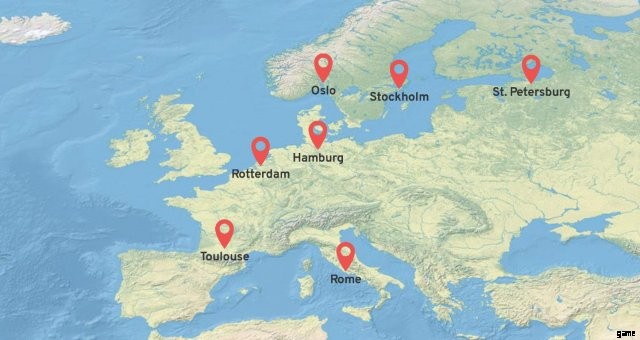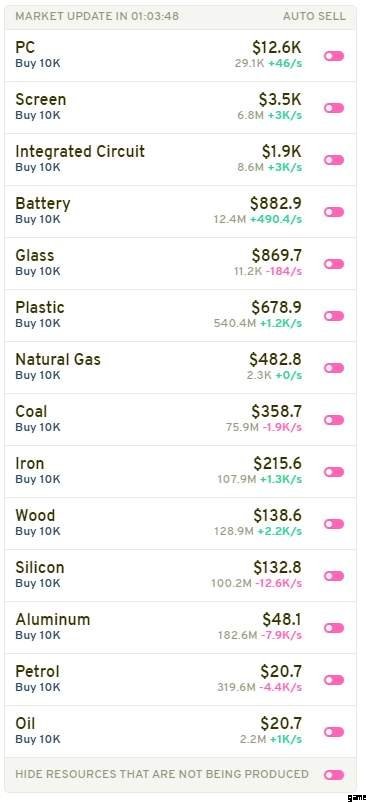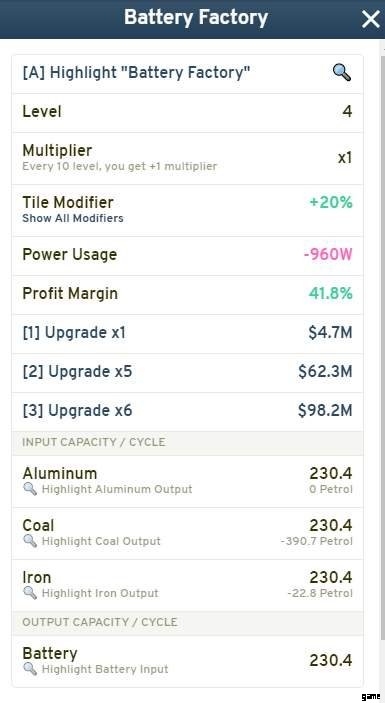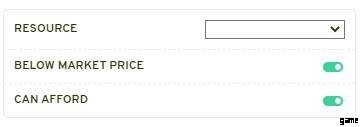業界のアイドル – 3 つの広範な戦略ガイド

ゲームで独自の拡張戦略を進化させるための 3 つの広範な戦略といくつかのヒントを概説する業界アイドル ガイド。
3 つの大まかな戦略のガイド
はじめに
このガイドでは、広い範囲で 3 つの戦略を提供しますが、これらの各戦略は、具体的にどのように使用されるか、どのマップが使用されるかなどによって大きく異なる可能性があることに注意してください。
無赤字戦略
無赤字方式とは、消費者向け製品の生産に必要なすべての材料をプレーヤーが独自に生産する方式です。 (その生産者の製品ラインの最後にある製品)この方法では、消費者製品が販売され(通常、自動販売または自動販売とプレーヤー取引の組み合わせを使用して)、それらの製品の販売による収益がプレーヤーの時価総額を拡大するための主要な手段です。
この戦略では、プレーヤーは、トレード センターまたはプレーヤーの取引エリアから中間リソースを購入する必要なく、消費財を生産します。基本的に、すべての製品の生産は、すべての消費者製品を生産するのに十分な量、またはわずかな余剰で稼働しています。理想的には、プレーヤーが卸売注文に対応できるように、各製品の生産にわずかな余剰があります。
無赤字法の進行は安定していますが、一般的には遅く、プレーヤーは徐々にレベルを上げ、各消費者製品とその複合材のインプット/アウトプットを増やします。これにより、収益が徐々に増加し、運用コストがなくなります。無赤字方式でのマップのリセットは通常、プレーヤーがリセットできる $wiss の量に満足している場合 (特定のアップグレードを念頭に置いている場合があります)、またはすべてを売却するための自動販売能力がなくなった場合に発生します。
ノーデフィシット方式の特徴
- 収益と時価総額の伸びは緩やかです。
- 生産、燃料、出力の安定性は非常に高いです。
- 運営費はかかりません。
- この方法は、成長と拡大へのより系統的なアプローチに例えられます。
赤字なしの方法のヒント
- 価格変動の激しい商品 (ビットコインとドージコイン) に依存しないようにしてください。時価総額と受け取った合計 $wiss を膨らませるために、それらの製品の適切な市場価格を待つ必要があります。
- 短い間隔で製品ラインをアップグレードします。残高が少し増えるのを待ってから、各生産エリアをゆっくりとアップグレードし、生産ラインを進んでください。
- 特に実行の中期と後期では、重鉄、シリコン バレー、アルミニウム製錬、産業革命、森林伐採、油井のスーパーチャージなどのポリシーが特に役立ちます。ポリシーポイントは、鉄、シリコン、アルミニウム、石炭、木材、および石油の生産にそれぞれ2倍の効果的な乗数を提供します(ポリシーがアクティブな間)。 720 ポリシー ポイントがかかります
- これらすべての乗数を一度に実行するための 1 秒あたり。追加のポリシーを有効にしている場合はさらに多くなります。
- 製品の次の層を構築する前に必要なリソースを確保できるように、最初に低層の製品をアップグレードすることをお勧めします。これは、そもそも赤字に陥るのを避けるのに役立ちます。
- 赤字で運営している場合は、最高層から最低層まで赤字を埋めてください。これにより、赤字の製品の数がなくなり、同じ生産タイプを繰り返しアップグレードする必要がなくなります。
- 常に隣接クラスターを最適化するように建物エリアを計画し (生産をクラスター化して隣接ボーナスを得る)、建設前に各エリアのタイル修飾子を確認して、生産性を最大限に高めてください。
- 過度の余剰がある場合は、統計センターでそれらの製品を見つけ、可能な場合は建物を格下げまたは削除して、許可を取得してください。
高赤字戦略
高赤字方式は、プレイヤーが消費者向け製品を製造するために必要な材料の一部のみを製造する方式です。 (その生産者の製品ラインの最後にあるすべての製品) この方法では、収益と成長がはるかに迅速に達成され、通常ははるかに高いレベルで見られます。ただし、この方法では、赤字を補うのに十分なリソースを購入する必要があるため、運用コストが大きくなります。
この方法では、消費者製品は自動販売、または自動販売とプレーヤー取引の組み合わせによって販売され、収益を蓄積し、赤字商品の購入は、取引センター、プレーヤー取引、またはより一般的には「Shopping Spree」ポリシーを通じて行われます [拡張パック1]。高赤字法で資金調達と時価総額を引き上げるには、会社の購入と運営にかかる費用よりもかなり高い収入が必要です。これは、利益率によって達成されます。以下は、利益率がどのように機能するか、および生産について考慮した選択を行うことで利益を最適化する方法の簡単な内訳です。
利益率は非常に単純に機能します。建物の利益率は、製品のすべての複合要素を個別に販売するのではなく、その建物の純利益の割合です。以下の例を見てください。


この例では、バッテリー工場は 230.4 個のバッテリーを生産するために 230.4 個のアルミニウム、石炭、および鉄を消費しています。各アイテムの価格は、最初のスクリーンショットに表示されています。 (上) 230.4 個のバッテリーを生産するための総コスト (トレード センターからリソースを購入した場合) は $143,400.96 です。
- (230.4 * 358.7) + (230.4 * 215.6) + (230.4 * 48.1)
230.4 バッテリーの総販売価格 (または価値) は 203,420.16 ドルであるため、この工場でバッテリーを生産すると、60,019.2 ドル (生産サイクルあたり) の利益が得られます。この利益を原価に分割して、純利益率を得ることができます。
- ((60019.2 / 143400.96) * 100)
この純利益率は約 41.8% で、バッテリー工場で見られるのとまったく同じ値です。わかりました。これで、利益率とは何か、そして 1 つの工場で利益率がどのように機能するかがわかりました。 However, this applies to only one production. In reality, you will be producing things comprised of multiple composite products. In those cases, the net profit margin on the final factory will be the net profit margin that that factory is generating in regards to its own composite products, not the raw inputs required to create it. For example, Software Companies will show a profit margin that is based upon the profit returned from the prices of Phones, PCs, and Books in comparison with the value of Software.
It does not consider the materials to produce each of those respective composites. To calculate the profit margin for that entire production line leading up to and including that product (You would want to know this if your factories were producing intermediate products but purchasing the raw materials to produce those) you can sum up a list of all the raw materials involved in producing that product, and then run the same calculation that we saw above. The below equation will hence give you the profit margin for that production line (It assumes that there are 4 raw inputs involved in creating the end product).
- (((Quantity of Final Product Produced * Value of Final Product)- Total Costs) / Total Costs)
Where:
- Total costs =((Quantity of Input * Price of Input) + (Quantity of Input * Price of Input) + (Quantity of Input * Price of Input) + (Quantity of Input * Price of Input))
Profit margins are important in High-Deficit methods because they dictate how much profit you will make. If your production lines are making a negative profit margin, you will be losing money every second because your costs are outweighing your profits. Profit margins are not completely in your control, but in order to maximize your total profit margin and maximize profits, you should aim to extend your production lines as long as possible, since profit margins have a rolling effect down the production line. Note that resources for fuel and power can also be purchased using deficit methods such as the Shopping Spree policy. [Expansion Pack 1]
An often successful strategy within the High-Deficit Method is to have two main products or product types that you sell; one, typically with a more consistent market price (For example, Software &Consoles) that you sell constantly, and another, typically more volatile (Internet or Dogecoin) that you produce at a lower rate than you can autosell, but only sell when the price is optimal. This gives you a consistent revenue stream and makes the most of production efficiency (not allocating too much of your resources to high volatility products) while giving boost sell points as well. However, there are countless variations and ways to operate your company in a deficit, this is just an example I’ve personally observed.
Features of the High Deficit Method
- Growth in revenue and market cap is typically unstable but rapid in times of growth.
- Small falls in culture production (to run shopping spree and production policies) will bring things to a halt; your run is much more fragile.
- Stability in production, fuel, and power is very low.
- There are outgoing costs which have to be outweighed by your total revenue.
- This method is likened to a more sporadic and aggressive approach to expansion.
- Purchased deficits may be used to lighten the strain on permits or to completely replace the majority of production.
Tips for the High Deficit Method
- Just because you’re using a more profit-aggressive method, try to act methodically. Mindlessly upgrading things as soon as you can finance them is typically a bad idea. If you over expand one chain and receive a negative profit margin you could see a serious fall in profit.
- It’s a good idea to allocate your limited production inputs to the more expensive materials that are specific to your location. If plastic prices are high on your map, try producing plastic independently and buying a majority share in the rest of your resources.
- Always upgrade your factories from the simplest moving toward more and more complex products. This will ensure that your purchases [Shopping Spree] will be that of the lowest tier and not something part way up the production chain.
- Don’t use this strategy needlessly. If you have the cash and plenty of remaining permits, it’s best to produce more resources independently and purchase a smaller share. This strategy is more intended for permit-tight situations, late game expansion, or specializing purchases for specific low quantity resources.
- When having a moderate to high reliance on this strategy, try and keep your major purchasing inputs close to your trade center. You want to really centralize production as much as possible because the Shopping Spree purchases [Expansion Pack 1] and any other purchases from the trade center or player trading will be sent to your trade center. Having a distanced production line will massively increase your fuel consumption and may even cause disruptions in resource flow.
Price &Volume Trading Methods
Market Trading is, in my opinion, mostly a sub-strategy and will barely ever be used as a main revenue stream before end-game progression. However, to completely ignore market trading methods as a part of your progression is adverse.
Trading items on the market (And by market I am referring to both offline trade center and online player trade markets) is a great way to increase your revenue, clear extra stock from mounting surpluses, make the most of your market cap on resets, and turn earned revenue into more revenue.
Since this is such a broad category and I don’t plan to outline any very specific market elements in this guide, I’m just going to run over some helpful tips and strategies for trading on the market in Industry Idle. Note that trading becomes more relevant as you progress in the game. If you are on one of your first runs, this information may not be helpful. Market trading is also helpful if you don’t have a lot of time to actively expand and can instead wait to fill orders and check market prices whenever you get the chance.
Tips:when &how to trade (For the best results)
Having foresight about when you plan to liquidate and reset are important for market trading. A good strategy during the hours (or days) leading up to reset is to save up cash and wait for a product priced under it’s typical market valuation. Then, buy as great a volume of the product as you can (using saved cash), and when there’s an upturn in the market, reset using your inflated market cap or autosell the product for profits is the stock rating is unfavourable to reset at that time. This strategy is good at any point in progression, not just before reset, but keep in mind that it’s most beneficial in the later stages when saving cash makes more sense than spending it on upgrading your production.
Another way to quickly make marginal gains in your market cap is to search the player market using the ‘Below Market Price’ &‘Can Afford’ filter toggles. Keep in mind this does not impede on your player trade quota. Holding onto these products or reselling them for a profit immediately afterward is a good way to make small jumps in market cap with excess cash.

Produce a surplus with intent to sell on the online market. A good idea is to produce a modest surplus in a product you are already autoselling. This means that when the price is most favourable and people are looking to liquidate their products rather than purchase more (at market price), you can sell your surplus on the online market at a reasonable way below the market price. People with higher autosell capacity or looking to reset will see this as a way to quickly increase valuation and you will in turn receive a heavy bonus.
Run stop-losses on the market! For those who don’t know, stop-loss orders are orders where, if the price falls or rises past a certain point, you automatically fill or place an order. This is useful so that even if you aren’t online, or if you’re working on other things, you can be buying products at lows and selling at highs. In Industry Idle, this can be (somewhat) replicated by placing low price buy orders and high price sell orders. Keep in mind there will be a cap to how far you can push the limits, depending on the market price, and you need the product in stock to make a sell order.
Search through buy orders first before making a sell order, there may be a product being ordered at a higher price than you would offer. At the moment there is no system to automatically fill your order if supply/demand prices cross over like this but I expect it won’t happen any time soon because the way the market currently works is that the entire quantity of an order has to be filled. Having this change would result in drastic market changes.
